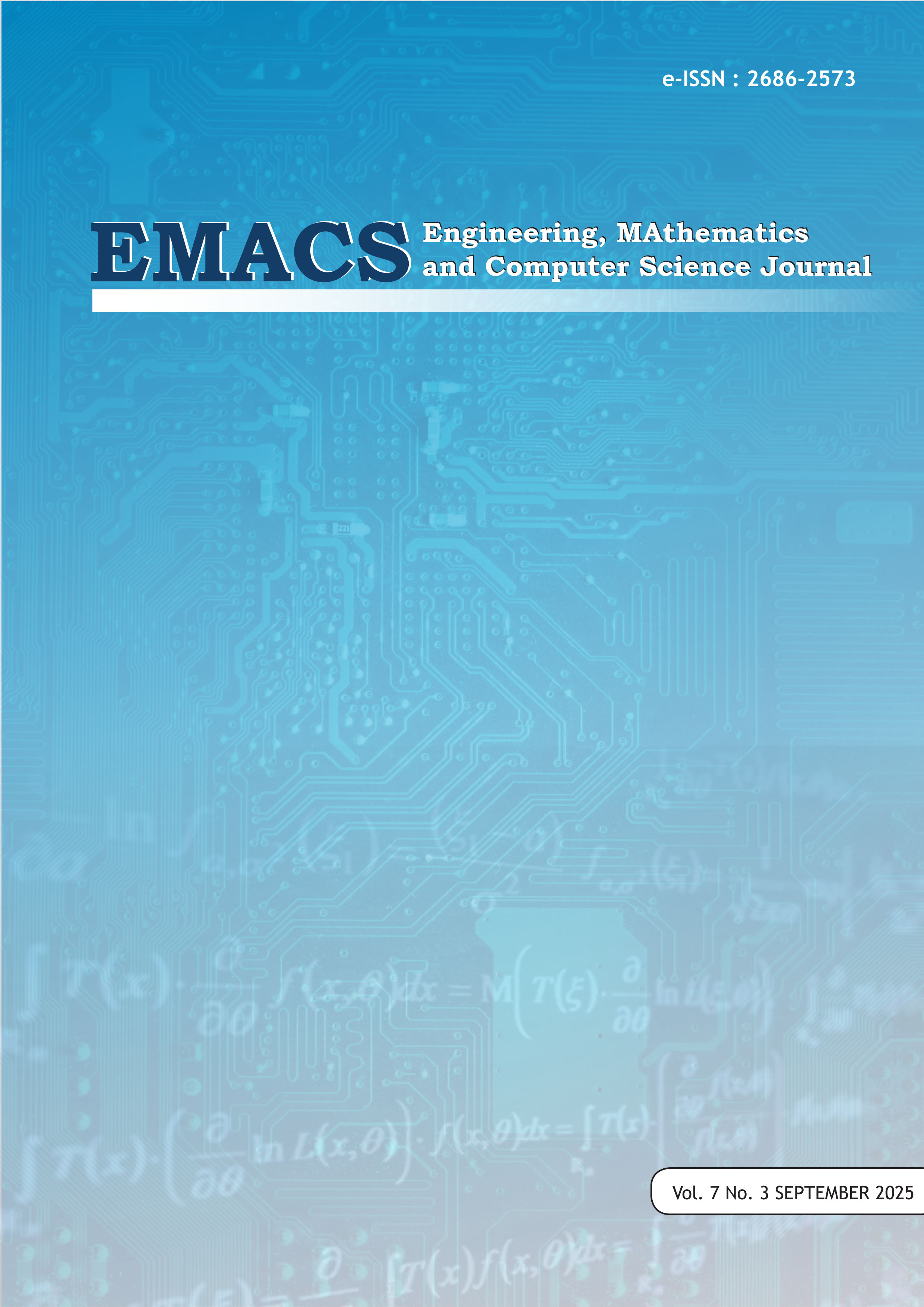Integration of Multi-Architecture Deep Learning Models for Pneumonia Detection Based on Chest X-Ray Imaging
DOI:
https://doi.org/10.21512/emacsjournal.v7i3.14336Keywords:
Pneumonia Detection, deep learning architectures, chest X-ray analysis, MobileNetV2 performance, clinical diagnosticsAbstract
Pneumonia remains a leading cause of child mortality worldwide, particularly in resource-limited settings where diagnostic tools and expertise are scarce. Recent advances in deep learning offer an opportunity to enhance pneumonia detection through automated analysis of chest X-ray images. This study evaluates the performance of ten state-of-the-art deep learning architectures, including VGG16, ResNet50, DenseNet121, and MobileNetV2, for pneumonia detection using the widely recognized "Chest X-Ray Images (Pneumonia)" dataset. The dataset underwent rigorous preprocessing, including image resizing, data augmentation, and class balancing, to optimize model training and improve generalization. Performance metrics such as accuracy, precision, recall, F1-score, and ROC-AUC were utilized to assess model effectiveness. Among the evaluated architectures, MobileNetV2 demonstrated the best performance with an accuracy of 97.51% and an AUC of 0.9941, highlighting its potential for reliable diagnostic applications. The results also emphasize the trade-offs between sensitivity and specificity across models, offering useful insights for real-world deployment. This study underscores the importance of leveraging deep learning models in clinical diagnostics, particularly in environments with limited healthcare resources. Beyond evaluating models, the findings provide evidence-based recommendations for selecting efficient architectures that balance accuracy and computational efficiency. Future work will focus on integrating multimodal datasets, improving explainability, and validating these models in diverse clinical environments to ensure scalability, trust, and generalizability for global health applications.
References
Asnaoui, K. El, Chawki, Y., & Idri, A. (2020). Automated Methods for Detection and Classification Pneumonia based on X-Ray Images Using Deep Learning. https://doi.org/https://doi.org/10.48550/arXiv.2003.14363
Barhoom, A. M. A., Samy, P., & Naser, S. A. (2022). Diagnosis of Pneumonia Using Deep Learning. In International Journal of Academic Engineering Research (Vol. 6). www.ijeais.org/ijaer
Bashar, A., Latif, G., Ben Brahim, G., Mohammad, N., & Alghazo, J. (2021). COVID-19 Pneumonia Detection Using Optimized Deep Learning Techniques. Diagnostics, 11(11), 1972. https://doi.org/10.3390/diagnostics11111972
Elshennawy, N. M., & Ibrahim, D. M. (2020). Deep-Pneumonia Framework Using Deep Learning Models Based on Chest X-Ray Images. Diagnostics, 10(9), 649. https://doi.org/10.3390/diagnostics10090649
Gabruseva, T., Poplavskiy, D., & Kalinin, A. A. (2020). Deep Learning for Automatic Pneumonia Detection. https://doi.org/10.1109/CVPRW50498.2020.00183
Gm, H., Kumar Gourisaria, M., Rautaray, S. S., & Pandey, M. (2021). PNEUMONIA DETECTION USING CNN THROUGH CHEST X-RAY. In Journal of Engineering Science and Technology (Vol. 16, Issue 1).
Hashmi, M. F., Katiyar, S., Keskar, A. G., Bokde, N. D., & Geem, Z. W. (2020). Efficient Pneumonia Detection in Chest Xray Images Using Deep Transfer Learning. Diagnostics, 10(6), 417. https://doi.org/10.3390/diagnostics10060417
Ibrahim, A. U., Ozsoz, M., Serte, S., Al-Turjman, F., & Yakoi, P. S. (2024). Pneumonia Classification Using Deep Learning from Chest X-ray Images During COVID-19. Cognitive Computation, 16(4), 1589–1601. https://doi.org/10.1007/s12559-020-09787-5
Islam, S. R., Maity, S. P., Ray, A. K., & Mandal, M. (2022). Deep learning on compressed sensing measurements in pneumonia detection. International Journal of Imaging Systems and Technology, 32(1), 41–54. https://doi.org/10.1002/ima.22651
Jain, R., Nagrath, P., Kataria, G., Sirish Kaushik, V., & Jude Hemanth, D. (2020). Pneumonia detection in chest X-ray images using convolutional neural networks and transfer learning. Measurement, 165, 108046. https://doi.org/10.1016/j.measurement.2020.108046
Jaiswal, A. K., Tiwari, P., Kumar, S., Gupta, D., Khanna, A., & Rodrigues, J. J. P. C. (2019). Identifying pneumonia in chest X-rays: A deep learning approach. Measurement, 145, 511–518. https://doi.org/10.1016/j.measurement.2019.05.076
Kareem, A., Liu, H., & Sant, P. (2022). Review on Pneumonia Image Detection: A Machine Learning Approach. Human-Centric Intelligent Systems, 2(1–2), 31–43. https://doi.org/10.1007/s44230-022-00002-2
Kementrian Kesehatan RI. (2019). Data Kasus Pneumonia Per Bulan di Tahun 2019. https://pusatkrisis.kemkes.go.id/data-kasus-pneumonia-per-bulan-di-tahun-2019
Kundu, R., Das, R., Geem, Z. W., Han, G.-T., & Sarkar, R. (2021). Pneumonia detection in chest X-ray images using an ensemble of deep learning models. PLOS ONE, 16(9), e0256630. https://doi.org/10.1371/journal.pone.0256630
Pant, A., Jain, A., Nayak, K. C., Gandhi, D., & Prasad, B. G. (2020). Pneumonia Detection: An Efficient Approach Using Deep Learning. 2020 11th International Conference on Computing, Communication and Networking Technologies (ICCCNT), 1–6. https://doi.org/10.1109/ICCCNT49239.2020.9225543
Paul Mooney. (2018). Chest X-Ray Images (Pneumonia).
Puneet Gupta. (2021). Pneumonia Detection Using Convolutional Neural Networks. International Journal for Modern Trends in Science and Technology, 7(01), 77–80. https://doi.org/10.46501/IJMTST070117
Racic, L., Popovic, T., cakic, S., & Sandi, S. (2021). Pneumonia Detection Using Deep Learning Based on Convolutional Neural Network. 2021 25th International Conference on Information Technology (IT), 1–4. https://doi.org/10.1109/IT51528.2021.9390137
Rahman, T., Chowdhury, M. E. H., Khandakar, A., Islam, K. R., Islam, K. F., Mahbub, Z. B., Kadir, M. A., & Kashem, S. (2020). Transfer Learning with Deep Convolutional Neural Network (CNN) for Pneumonia Detection Using Chest X-ray. Applied Sciences, 10(9), 3233. https://doi.org/10.3390/app10093233
Saul, C. J., Urey, D. Y., & Taktakoglu, C. D. (2019). Early Diagnosis of Pneumonia with Deep Learning. http://arxiv.org/abs/1904.00937
Sharma, S., & Guleria, K. (2023). A Deep Learning based model for the Detection of Pneumonia from Chest X-Ray Images using VGG-16 and Neural Networks. Procedia Computer Science, 218, 357–366. https://doi.org/10.1016/j.procs.2023.01.018
Singh, S. (2021). Pneumonia Detection using Deep Learning. 2021 4th Biennial International Conference on Nascent Technologies in Engineering (ICNTE), 1–6. https://doi.org/10.1109/ICNTE51185.2021.9487731
UNICEF Data. (2024). Pneumonia. https://data.unicef.org/topic/child-health/pneumonia/
Varshni, D., Thakral, K., Agarwal, L., Nijhawan, R., & Mittal, A. (2019). Pneumonia Detection Using CNN based Feature Extraction. 2019 IEEE International Conference on Electrical, Computer and Communication Technologies (ICECCT), 1–7. https://doi.org/10.1109/ICECCT.2019.8869364
World Health Organization. (2017). Ending preventable child deaths from pneumonia and diarrhoea by 2025. https://www.who.int/news/item/13-01-2017-ending-preventable-child-deaths-from-pneumonia-and-diarrhoea-by-2025
Yang, Y., & Mei, G. (2022). Pneumonia Recognition by Deep Learning: A Comparative Investigation. Applied Sciences, 12(9), 4334. https://doi.org/10.3390/app12094334
Yaseliani, M., Hamadani, A. Z., Maghsoodi, A. I., & Mosavi, A. (2022). Pneumonia Detection Proposing a Hybrid Deep Convolutional Neural Network Based on Two Parallel Visual Geometry Group Architectures and Machine Learning Classifiers. IEEE Access, 10, 62110–62128. https://doi.org/10.1109/ACCESS.2022.3182498
Yue, Z., Ma, L., & Zhang, R. (2020). Comparison and Validation of Deep Learning Models for the Diagnosis of Pneumonia. Computational Intelligence and Neuroscience, 2020, 1–8. https://doi.org/10.1155/2020/8876798
Downloads
Published
How to Cite
Issue
Section
License
Copyright (c) 2025 Ivan Sebastian Edbert, Louis Oktovianus, Robert Tanriwan, Alvina Aulia

This work is licensed under a Creative Commons Attribution-ShareAlike 4.0 International License.
Authors who publish with this journal agree to the following terms:
- Authors retain copyright and grant the journal right of first publication with the work simultaneously licensed under a Creative Commons Attribution License - Share Alike that allows others to share the work with an acknowledgment of the work's authorship and initial publication in this journal.
- Authors are able to enter into separate, additional contractual arrangements for the non-exclusive distribution of the journal's published version of the work (e.g., post it to an institutional repository or publish it in a book), with an acknowledgment of its initial publication in this journal.
- Authors are permitted and encouraged to post their work online (e.g., in institutional repositories or on their website) prior to and during the submission process, as it can lead to productive exchanges, as well as earlier and greater citation of published work.
USER RIGHTS
All articles published Open Access will be immediately and permanently free for everyone to read and download. We are continuously working with our author communities to select the best choice of license options, currently being defined for this journal as follows: Creative Commons Attribution-Share Alike (CC BY-SA)





